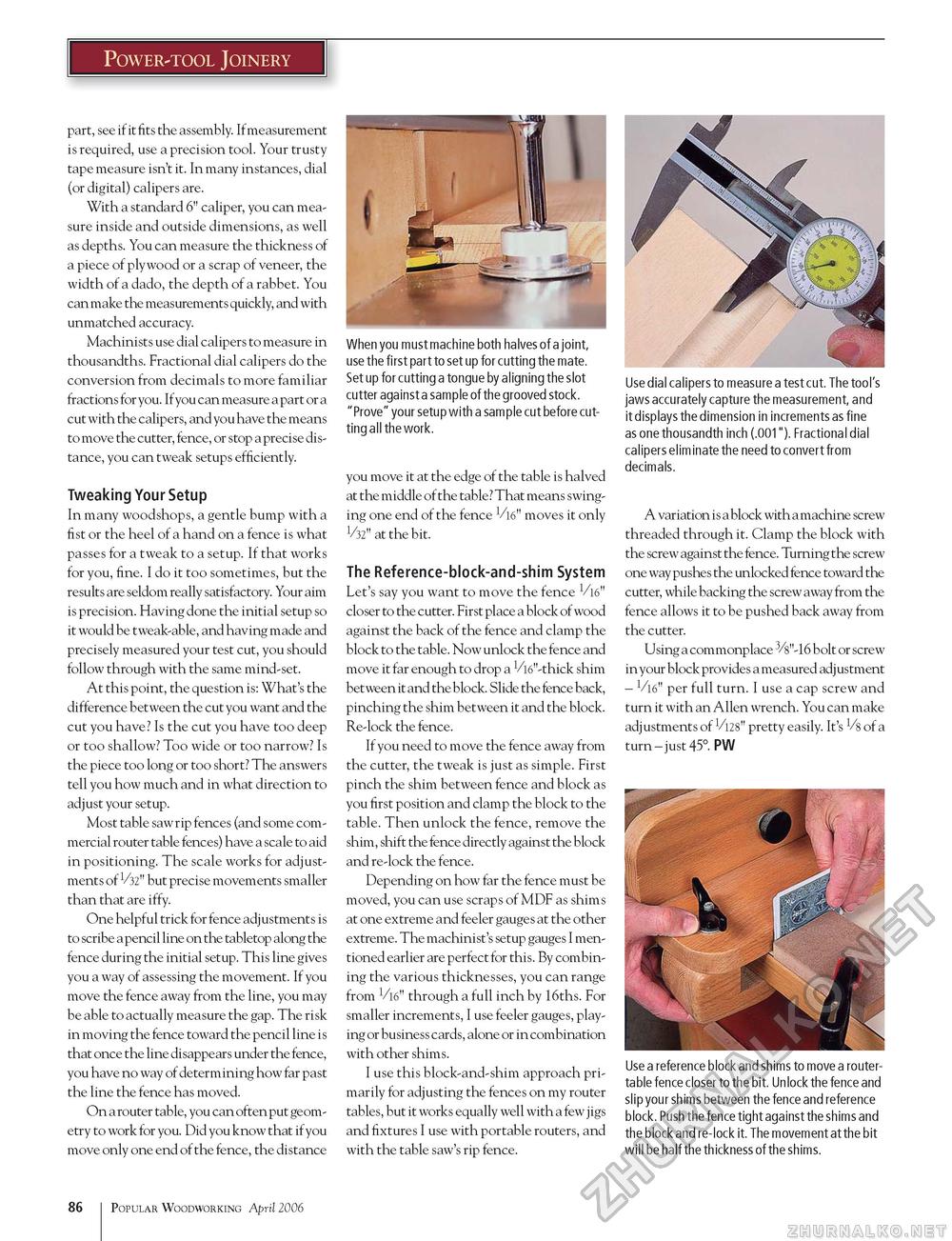Popular Woodworking 2006-04 № 154, страница 89
Power-tool Joinery part, see if it fits the assembly. If measurement is required, use a precision tool. Your trusty tape measure isn't it. In many instances, dial (or digital) calipers are. With a standard 6" caliper, you can measure inside and outside dimensions, as well as depths. You can measure the thickness of a piece of plywood or a scrap of veneer, the width of a dado, the depth of a rabbet. You can make the measurements quickly, and with unmatched accuracy. Machinists use dial calipers to measure in thousandths. Fractional dial calipers do the conversion from decimals to more familiar fractions for you. If you can measure a part or a cut with the calipers, and you have the means to move the cutter, fence, or stop a precise distance, you can tweak setups efficiently. Tweaking Your Setup In many woodshops, a gentle bump with a fist or the heel of a hand on a fence is what passes for a tweak to a setup. If that works for you, fine. I do it too sometimes, but the results are seldom really satisfactory. Your aim is precision. Having done the initial setup so it would be tweak-able, and having made and precisely measured your test cut, you should follow through with the same mind-set. At this point, the question is: What's the difference between the cut you want and the cut you have? Is the cut you have too deep or too shallow? Too wide or too narrow? Is the piece too long or too short? The answers tell you how much and in what direction to adjust your setup. Most table saw rip fences (and some commercial router table fences) have a scale to aid in positioning. The scale works for adjustments of V32" but precise movements smaller than that are iffy. One helpful trick for fence adjustments is to scribe a pencil line on the tabletop along the fence during the initial setup. This line gives you a way of assessing the movement. If you move the fence away from the line, you may be able to actually measure the gap. The risk in moving the fence toward the pencil line is that once the line disappears under the fence, you have no way of determining how far past the line the fence has moved. On a router table, you can often put geometry to work for you. Did you know that if you move only one end of the fence, the distance When you must machine both halves of a joint, use the first part to set up for cutting the mate. Set up for cutting a tongue by aligning the slot cutter against a sample of the grooved stock. "Prove" your setup with a sample cut before cutting all the work. you move it at the edge of the table is halved at the middle of the table? That means swinging one end of the fence Vl6" moves it only 1/32" at the bit. The Reference-block-and-shim System Let's say you want to move the fence 16" closer to the cutter. First place a block of wood against the back of the fence and clamp the block to the table. Now unlock the fence and move it far enough to drop a 1/16"-thick shim between it and the block. Slide the fence back, pinching the shim between it and the block. Re-lock the fence. If you need to move the fence away from the cutter, the tweak is just as simple. First pinch the shim between fence and block as you first position and clamp the block to the table. Then unlock the fence, remove the shim, shift the fence directly against the block and re-lock the fence. Depending on how far the fence must be moved, you can use scraps of MDF as shims at one extreme and feeler gauges at the other extreme. The machinist's setup gauges I mentioned earlier are perfect for this. By combining the various thicknesses, you can range from V16" through a full inch by 16ths. For smaller increments, I use feeler gauges, playing or business cards, alone or in combination with other shims. I use this block-and-shim approach primarily for adjusting the fences on my router tables, but it works equally well with a few jigs and fixtures I use with portable routers, and with the table saw's rip fence. Use dial calipers to measure a test cut. The tool's jaws accurately capture the measurement, and it displays the dimension in increments as fine as one thousandth inch (.001"). Fractional dial calipers elim inate the need to convert from decimals. A variation is a block with a machine screw threaded through it. Clamp the block with the screw against the fence. Turning the screw one way pushes the unlocked fence toward the cutter, while backing the screw away from the fence allows it to be pushed back away from the cutter. Using a commonplace 3/s"-16 bolt or screw in your block provides a measured adjustment - V^" per full turn. I use a cap screw and turn it with an Allen wrench. You can make adjustments of V12S" pretty easily. It's Vs of a turn - just 45°. PW Use a reference block and shims to move a router-table fence closer to the bit. Unlock the fence and slip your shims between the fence and reference block. Push the fence tight against the shims and the block and re-lock it. The movement at the bit will be half the thickness of the shims. 86 Popular Woodworking April 2006 |








